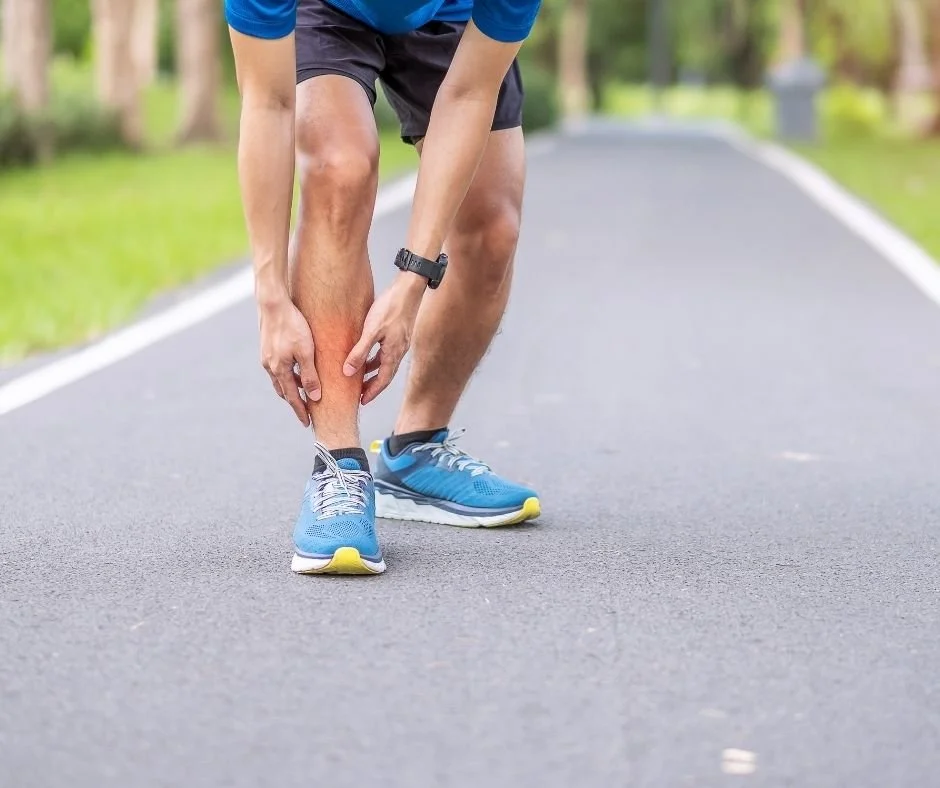The 3 Types Of Shin Splints That Runners Need To Know
Many of the runners that we see in the clinic, come in with pain at the front of their shins - or what we call shin splints. Maybe you’ve experienced shin pain if you’ve gone for a big run. But did you know that not all shin splints are the same?
In fact, there are 3 completely different types of shin splints that can occur, and each of these may need to be treated slightly differently to the other.
1. Medial Tibial Stress Syndrome
The first is what we call Medial Tibial Stress Syndrome. This is the classic type of shin splints which commonly presents as pain on the inside edge of the shin bone, which all the muscles at the front of your leg attach on to as they run down your leg and into your foot. What happens with medial tibial stress syndrome is that the muscles in your shin get really tight and start pulling on the attachment on the edge of your shin bone and this becomes really painful.
To treat medial tibial stress syndrome, we need to settle the inflammation down around the attachment on your shin bone and then get those muscles to relax. This can be done with a combination of massage, stretching and dry needling as well as some taping techniques.
2. Compartment Syndrome
The second type of shin splints is called Compartment Syndrome. When we run, there is an increase in blood flow which moves into the working muscles, like the muscles at the front of your legs. But sometimes this increase in blood flow can create an enormous amount of pressure to build in the front of the legs, causing shin pain. Maybe you’ve experienced this - you start your run, and after a few minutes you feel the pressure build and build in the front of your legs until you have to stop. And after a minute or two of rest, you feel the pressure subside as all that blood moves back out of the muscles in the front of your legs.
This is because there are compartments in the front of your legs that hold all the muscles and blood vessels and nerves in place, and when the pressure gets too high in these compartments, it can become really painful.
3. Tibial Stress Fracture
The third type of shin splints is what actually presents as a Tibial Stress Fracture, or a small micro-fracture in the shin bone. Sometimes this can begin as the first type of shin splints that we discussed earlier - medial tibial stress syndrome. But if it is not properly addressed, all that pulling and pulling of those tight muscles on your shin bone, as well as all the force that goes through your bones as you run, can overload the shin bone, and it starts to fail, leading to shin pain. This highlights the importance of listening to your body, and addressing any problems that occur quickly. Tibial stress fracture can be tricky to treat and usually requires a period of rest from running as well as some specific strengthening exercises to offload the shin bone.
What are the main causes of shin splints?
Shin splints refer to pain in the lower legs that is caused by overuse or repetitive strain. The main causes of shin splints are:
- Running or walking on hard surfaces: This can put excessive strain on the bones and muscles of the lower legs, resulting in shin splints.
- Wearing supportive shoes: Shoes that do not provide enough support can also lead to shin splints. The best shoes for preventing shin splints are those with good arch support and cushioning.
- Weak muscles: If the muscles around the shins are weak, they will be more vulnerable to injury and shin pain. Therefore, it is important to perform exercises that strengthen the muscles of the lower legs.
By being aware of the main causes of shin splints, you can take steps to prevent them from occurring. If you do experience shin pain, it is important to see a doctor or physiotherapist to ensure that it is not a more serious condition.
How can I prevent shin splints?
There are several things that you can do to prevent shin splints:
- Choose the right shoes: Wearing supportive shoes with good arch support and cushioning can help to prevent shin splints.
- Warm up properly: Warming up before exercise helps to prepare the muscles and joints for activity, reducing the risk of injury and shin pain.
- Correct your running technique
- Cool down: Cooling down after exercise helps to reduce muscle soreness and the risk of shin splints.
- Strengthen the muscles around the shins: Exercises that strengthen the muscles of the lower legs can help to prevent shin splints.
Are shin splints permanent?
While shin splints can be extremely painful, they are not typically permanent. With proper treatment and rest, most people make a full recovery within a few weeks or months. However, some people may experience recurrent shin splints or develop chronic pain in the area. If you experience chronic pain or recurrent shin splints, it is important to see a doctor or physiotherapist to rule out other causes of pain and develop a treatment plan.
How are shin splints diagnosed?
Shin splints are usually diagnosed based on symptoms and a physical examination. Your physio will ask about your medical history and symptoms and then examine your shin for tenderness, swelling, and bruising. X-rays or MRI may sometimes be ordered to rule out other causes of shin pain.
How are shin splints treated?
Treatment for shin splints typically involves load modification, which means reducing the amount of stress on the legs. This can be done by reducing the intensity or frequency of exercise, or by changing the type of surface that is being used. In some cases, physiotherapy may also be recommended. This can help to stretch and strengthen the muscles in the lower legs, which can reduce the risk of shin splints developing in the future.
Shin splints are a common problem for runners, and they can be frustrating to deal with. But by understanding the different types of shin splints, you can take steps to prevent them and speed up your recovery time if you do get them. We hope this article has helped you learn more about shin splints and how to treat them.





